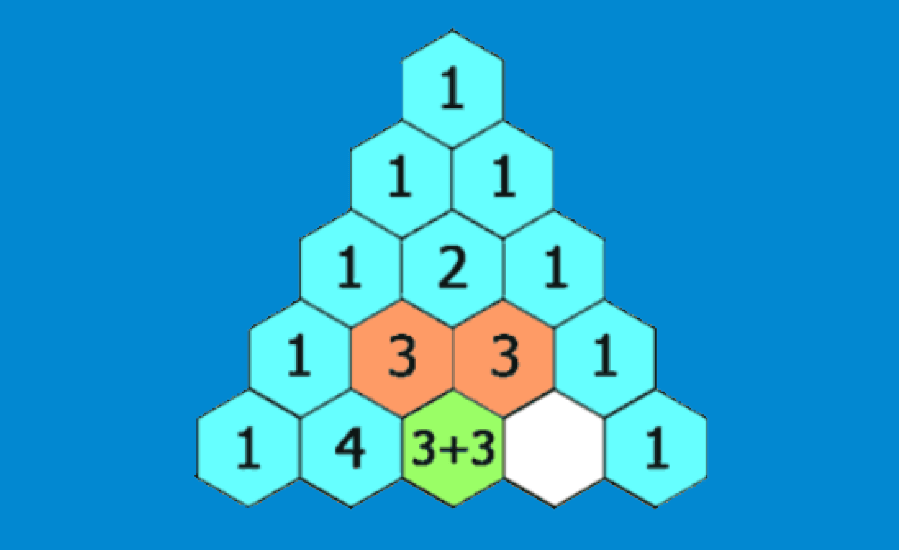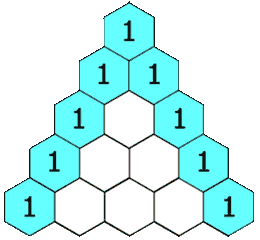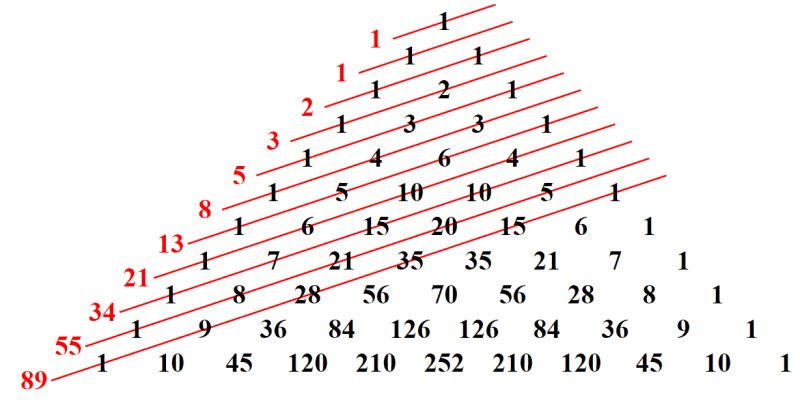Pascal’s triangle is a type of number pattern. The numbers are arranged in a way that reflects a triangle. First, the 1 is placed at the top. Then, the rest of the numbers are arranged in a triangular pattern. The numbers we get in each step are the sum of the two numbers above the number. This is a concept similar to triangular numbers.
Here, we will look at what Pascal’s triangle is and learn how to build it. In addition, we will learn about the fundamental properties of Pascal’s triangle.
ALGEBRA

Relevant for…
Learning about the fundamental properties of Pascal’s triangle.
ALGEBRA

Relevant for…
Learning about the fundamental properties of Pascal’s triangle.
Definition of Pascal’s triangle
Pascal’s triangle can be introduced through a set of rules. To form Pascal’s triangle, we start with 1 at the top and place “1” along the two sides of the triangle. Each new number will be located between and below two numbers, and its value is equal to the sum of those two numbers.
The theoretical triangle is infinite and can continue indefinitely until needed.
Construction of Pascal’s triangle
The rows in Pascal’s triangle are numbered starting from 0, so the top row is row 0. The easiest way to build Pascal’s triangle is to start from row zero and write only the number 1.
From there, we get each number in the next row by adding the two numbers that are directly to the top left and right. If there is no number to the right or left, we replace a zero with that number and proceed with the addition.
The following is an illustration of how to construct Pascal’s triangle:

Properties of Pascal’s triangle
The following are the most important properties of Pascal’s triangle:
- Each number is the sum of the two numbers above it.
- All outside numbers are equal to 1.
- Pascal’s triangle is symmetric.
- The first diagonal shows the counting numbers.
- The sums of the rows give the powers of 2.
- Each row gives the digits of the powers of 11.
- Each element represents the combination $latex _{m} C_{n}$, where, m is the row of the element and n is the position of the element in the row.
- Each row represents the binomial coefficients.
- Fibonacci numbers are along the diagonals.
Pascal’s triangle patterns
Sum of the rows
One of the interesting properties of the triangle is that the sum of the numbers in a row equals $latex {{2}^n}$, where, n corresponds to the number in the row. For example, we have:
- $latex 1=1={{2}^0}$
- $latex 1+1=2={{2}^1}$
- $latex 1+2+1=4={{2}^2}$
- $latex 1+3+3+1=8={{2}^3}$
- $latex 1+4+6+4+1=16={{2}^4}$
Prime numbers in the triangle
Another visible pattern in the triangle relates to prime numbers. If a row begins with a prime number or is a row with a prime number, all the numbers in that row, not including 1, are divisible for that prime number.
If we look at row 5 (1, 5, 10, 10, 5, 1) we can see that 5 and 10 are divisible by 5. However, for a row composed like row 8 (1, 8, 28, 56, 70, 56, 28, 8, 1), 28 and 70 are not divisible by 8.
Fibonacci sequence in the triangle
By adding the numbers on the diagonals in Pascal’s triangle, we can obtain the Fibonacci sequence, as shown in the figure:

Binomial expansion with Pascal’s triangle
Pascal’s triangle defines the coefficients that appear in binomial expressions. This means that row n of Pascal’s triangle contains the coefficients of the expanded expression of the binomial $latex {{(x + y)}^n}$.
The coefficients of the expansion can be expressed as a $latex k = _{n}C_{k}$. For example, we can expand the expression for the binomial $latex {{x + y}^3}$:
$${{(x+y)}^3}=_{3}C_{0}{{x}^3}+_{3}C_{1}{{x}^2}y+_{3}C_{2}x{{y}^2}+_{3}C_{3}{{y}^3}$$
$latex =(1){{x}^3}+(3){{x}^2}y+(3)x{{y}^2}+(1){{y}^3}$
In this expression, we have $latex n=3$, which means that we use the numbers from row 3 of Pascal’s triangle, which are 1, 3, 3, 1.
See also
Interested in learning more about Pascal’s triangle and the binomial theorem? Take a look at these pages:



